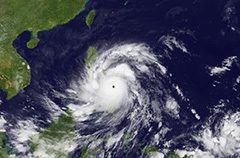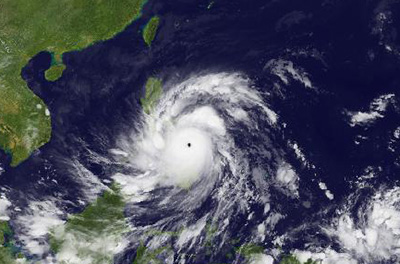What Makes A Super Typhoon Like Haiyan?
|
Image: Kochi University, Tokyo
|
Friday 8th November, 2013, the most powerful typhoon to make landfall ever recorded swiped at the southern shores of Samar Island and smashed, like a freight train on steroids, into the town of Guiuan, Samar, and the city of Tacloban, Leyte; it pushed before it a storm surge – a wall of water – some 5 meters high (higher by some accounts). This “natural disaster”, that has possibly claimed upwards of 10,000 lives, should be a wake up call to the World because the cause is anything but natural. At the moment, only one person has shown the passion and dedication necessary to say it like it is . . .
11th November, 2013, Warsaw: Philippine Climate Change Commissioner, Naderev “Yeb” Saño:
“To anyone outside who continues to deny the reality that is climate change, I dare them, I dare them to get off their ivory towers and away from the comfort of their armchairs. I dare them to go to the islands of the Pacific, the Caribbean, the Indian ocean and see the impacts of rising sea levels; to the mountainous regions of the Himalayas and the Andes to see communities confronting glacial floods, to the Arctic where communities grapple with the fast dwindling sea ice caps, to the large deltas of the Mekong, the Ganges, the Amazon, the Nile where lives and livelihoods are drowned, to the hills of Central America that confronts similar monstrous hurricanes, to the vast savannas of Africa where climate change has likewise become a matter of life and death as food and water become scarce.”
This particular typhoon, internationally named Haiyan (locally: Yolanda), started life as a typical nondescript, tropical storm when it was some 2,000 nautical miles East of the Philippines, reported first on the Puerto Galera Yacht Club website Twitter account: @pgycnews. It gained strength by extracting and using the warmth from the surface of the Pacific Ocean to accelerate the upward movement of the air near the center, at the same time as liberating vast quantities of water vapor and carrying it aloft, ready to unload it as rain when over land.
Why was there so much heat in the ocean to build this powerful typhoon, with utterly devastating 200 mile per hour winds?
The answer is quite complex because it is only in recent years that we have studied in detail how the oceans are warmed.
What we know is that as the sun penetrates the cushion of gases (the atmosphere) above and around the Earth, it heats the land and the water. At night, some of this heat escapes into space. The atmosphere is like a blanket and for many tens of thousands of years it has been just thick enough to retain just enough heat by night so that by morning, when the sun rises over the Eastern horizon again, there is just enough heat around to allow life to flourish. In fact, all living things that we see on land and in the oceans have adapted themselves to the constant heating of the sun by day and the retention of heat by the blanket at night.
The blanket (the atmosphere) holds the heat at night by virtue of just a handful of gases within the overall mix of gases. Principle amongst these heat retaining gases are Carbon Dioxide and Methane.
Carbon Dioxide and Methane have found a balance in the blanket over the eons, by virtue of the vast numbers of trees. Trees absorb Carbon Dioxide during the day and converted it into life giving Oxygen – taking the carbon element into their foliage and stems to grow taller and fatter. The Methane has been produced, in smaller quantities, by decaying vegetation and animal flatulence but, given a little time, Methane escapes the blanket in a fairly regular stream either, directly into space or, is transformed into other gases.
What has happened recently (the last hundred and fifty years or so) is that Man has pumped more Carbon Dioxide into the blanket by burning fossil fuels (coal, oil, “natural” gas) at an ever increasing rate and has cut more forests and converted the land for agriculture, which by comparison absorbs almost no carbon. As a result, the balance of gases in the blanket has changed (become thicker) and the blanket now retains more heat by night to pass on to the next day. Thus, the oceans (and the land), because they are in constant contact with the blanket, are warmer than before.
Because the oceans are warmer than before they can supply more energy to tropical storms so that these storms can become stronger more frequently.
But also, because the blanket is warmer, the vast areas of decaying vegetation that have been frozen for countless centuries (particularly in the northern extremes of Canada, Russia and Siberia), are now thawing. As they thaw they release the Methane, that was previously trapped within, faster than it can escape the blanket.
The bottom line is that, as Man continues to burn more and more fossil fuels and cuts more and more tress without replacing them, Man continue to upset the balance of the gases in the blanket and makes the air, the oceans and the land, warmer. As a result we can expect to witness more frequent and more powerful storms until we stop burning and cutting, and until we replace fossil fuels with renewable alternatives and start to replant the forests.
Let’s get real, and stop the burning and the cutting, and start using Mother Nature’s gifts of sunlight, wind, waves and tides; and, start rebuilding our society around values that are meaningful and sustainable through even a far reaching disaster.
I will leave the last paragraphs to Yeb Saño:
“I speak for the countless people who will no longer be able to speak for themselves after perishing from the storm. I speak also for those who have been orphaned by the storm. I speak for the people now racing against time to save survivors and alleviate the suffering of the people affected.
“We can take drastic action now to ensure that we prevent a future where super typhoons become a way of life. Because we refuse, as a nation, to accept a future where super typhoons like Haiyan become a way of life. We refuse to accept that running away from storms, evacuating our families, suffering the devastation and misery, counting our dead, become a way of life. We simply refuse to.”



 Satellite image Super Typhoon Haiyan before landfall
Satellite image Super Typhoon Haiyan before landfall